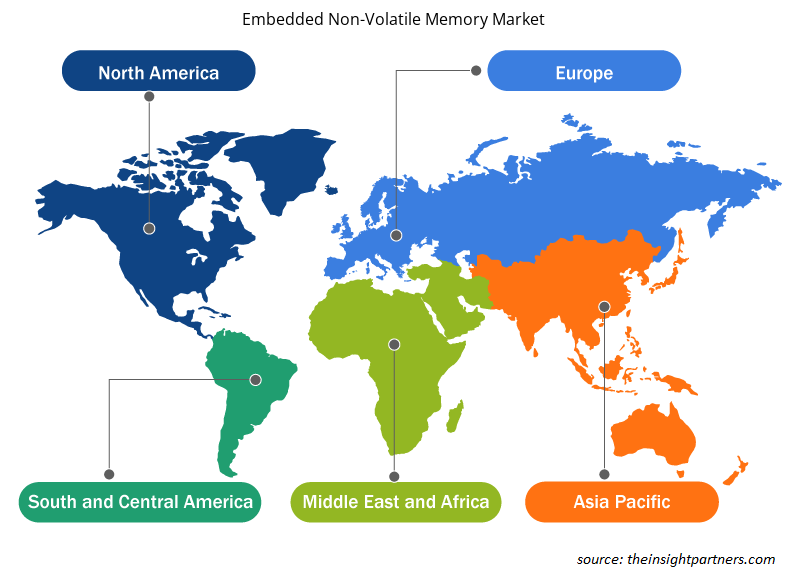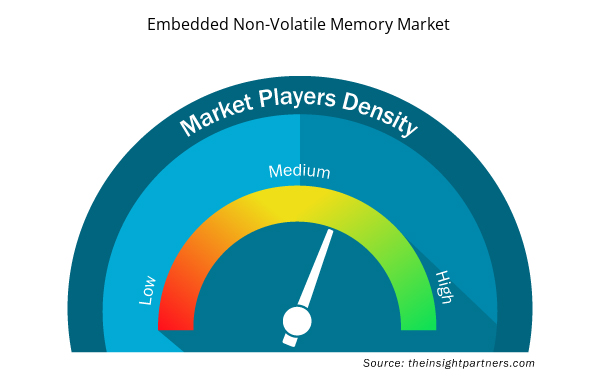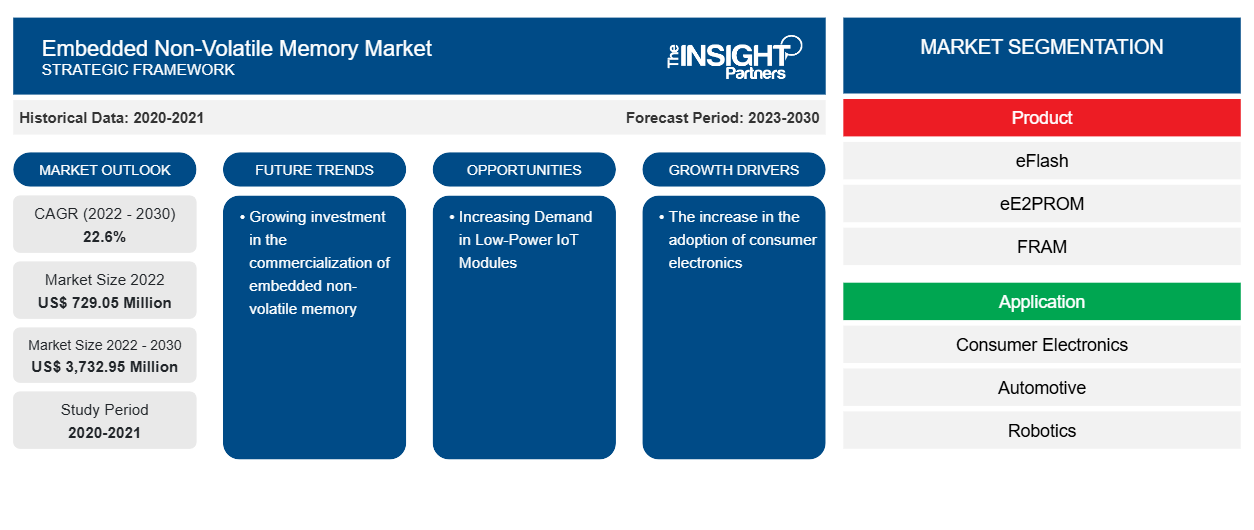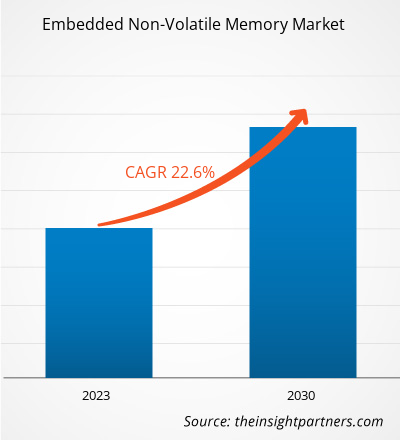組み込み不揮発性メモリの市場規模は、2022年の7億2,905万米ドルから2030年には37億3,295万米ドルに達すると予測されています。市場は2022年から2030年の間に22.6%のCAGRを記録すると予想されています。民生用電子機器の採用の増加と自動車産業の拡大は、今後も市場の主要なトレンドであり続けると思われます。
組み込み不揮発性メモリ市場分析
組み込み不揮発性メモリ市場の成長は、一人当たりの GDP の上昇により、一般大衆の間で高度な消費者向け電子機器の採用が増加したことに起因しています。自動車における高度な電子機器の採用の増加と接続デバイスの普及の増加も、市場の成長を後押ししています。さらに、IoT ソリューションの採用の増加とスマート シティ プロジェクトの拡大により、組み込み不揮発性メモリ市場は近い将来に拡大すると予測されています。
組み込み不揮発性メモリ市場の概要
組み込み不揮発性メモリ (eNVM) は、マイクロコントローラやハードウェアに統合され、データ保存に使用される小型チップです。保存されたデータは、プログラミング、暗号化、コーディング、識別、トリミング、冗長化の目的で使用されます。不揮発性メモリ システムには、絶縁体層に囲まれた導電性材料片を持つトランジスタが含まれます。マイクロコントローラに電源が投入されると、周囲の絶縁体によって少量の電気が閉じ込められ、不揮発性メモリがデータを保持できるようになります。組み込み不揮発性メモリの小型で高効率な点は、従来のスタンドアロンの不揮発性メモリに取って代わるものです。このメモリ技術は、マイクロコントローラ ベースのモノのインターネット (IoT) デバイスの重要な部分の 1 つになりつつあります。
要件に合わせてレポートをカスタマイズする
このレポートの一部、国レベルの分析、Excelデータパックなど、あらゆるレポートを無料でカスタマイズできます。また、スタートアップや大学向けのお得なオファーや割引もご利用いただけます。
- このレポートの主要な市場動向を入手してください。この無料サンプルには、市場動向から見積もりや予測に至るまでのデータ分析が含まれます。
組み込み不揮発性メモリ市場の推進要因と機会
成長する自動車産業
現代のテクノロジーの影響は、自動車業界に良い影響を与えています。デジタルテクノロジーの世界的な出現により、メーカーは自動車に高度なソリューションを実装することが可能になりました。今日、自動車には、ユーザーにとって運転をより安全で快適で楽しいものにするためのさまざまな高度なテクノロジーが搭載されており、自動車業界では組み込み不揮発性メモリの需要が高まっています。組み込み不揮発性メモリは、組み込みシステムに統合されており、通常の自動車とハイブリッド自動車の両方で広く使用されています。これらのメモリは、自動車のシステムが再起動した後、自動車ユーザーがコードやその他のデータを保存するのに役立ちます。組み込み不揮発性メモリは、電気自動車やハイブリッド自動車に組み込まれた ADAS テクノロジーで使用されます。電気自動車とハイブリッド自動車の需要の高まりが市場を牽引しています。たとえば、国際エネルギー機関 (IEA) によると、2022 年には電気自動車の販売台数が 1,000 万台増加すると予想されています。世界中で販売される新車の約 14% が電気自動車です。電気自動車の世界的な販売増加により、自動車メーカーによる組み込み不揮発性メモリの採用が増加しています。これらのメモリは、電源がない場合でもデータを保存するために使用されます。
成長する家電市場
世界中で消費者の可処分所得が増加し、個人の購買力が高まり、それがさらに家電製品の売上を後押ししています。都市化の進展と人々のライフスタイルの変化も、家電製品の売上に貢献するもう 1 つの要因です。家電市場の成長に伴い、スマートフォン、カメラ、スマートウォッチ、テレビ、スマート スピーカー、タブレットなど、さまざまな家電製品のマイクロコントローラーに搭載される組み込み不揮発性メモリの需要が高まっています。これは、データ ストレージ用のマイクロコントローラーをサポートします。
組み込み不揮発性メモリ市場レポートのセグメンテーション分析
組み込み不揮発性メモリ市場分析の導出に貢献した主要なセグメントは、製品とアプリケーションです。
- 製品に基づいて、組み込み不揮発性メモリ市場は、eFlash、eE2PROM、FRAM、その他に分類されます。eFlashセグメントは、2022年に最大の市場シェアを占めました。
- 用途別に見ると、市場は民生用電子機器、自動車、ロボット工学、その他に分類されています。ロボット工学セグメントは2022年に市場で大きなシェアを占めました。
地域別組み込み不揮発性メモリ市場シェア分析
組み込み不揮発性メモリ市場レポートの地理的範囲は、主に北米、アジア太平洋、ヨーロッパ、中東およびアフリカ、南米および中米の 5 つの地域に分かれています。
北米は2022年に世界市場で大きなシェアを占めます。この地域で組み込み不揮発性メモリの採用が増加すると予想されるのは、この地域の自動車および民生用電子機器市場の売上増加によるものです。米国、カナダ、メキシコでのEVの採用増加により、より安全でスマートで環境に優しい車を作るために隅々まで使用されているマイクロコントローラの必要性が高まります。この地域の自動車部門は、資本の増加と自動車の輸出の増加により、驚異的な成長を遂げています。組み込み不揮発性メモリは、先進運転支援システム(ADAS)や車載インフォテインメント(IVI)システムの開発もサポートしており、自動車をこれまで以上にスマートで接続性の高いものにしています。
組み込み不揮発性メモリ市場の地域別分析
予測期間を通じて組み込み不揮発性メモリ市場に影響を与える地域的な傾向と要因は、Insight Partners のアナリストによって徹底的に説明されています。このセクションでは、北米、ヨーロッパ、アジア太平洋、中東およびアフリカ、南米および中米にわたる組み込み不揮発性メモリ市場のセグメントと地理についても説明します。

- 組み込み不揮発性メモリ市場の地域別データを入手
組み込み不揮発性メモリ市場レポートの範囲
| レポート属性 | 詳細 |
|---|---|
| 2022年の市場規模 | 7億2,905万米ドル |
| 2030年までの市場規模 | 37億3,295万米ドル |
| 世界のCAGR(2022年 - 2030年) | 22.6% |
| 履歴データ | 2020-2021 |
| 予測期間 | 2023-2030 |
| 対象セグメント | 製品別
|
| 対象地域と国 | 北米
|
| 市場リーダーと主要企業プロフィール |
|
組み込み不揮発性メモリ市場のプレーヤー密度:ビジネスダイナミクスへの影響を理解する
組み込み不揮発性メモリ市場は、消費者の嗜好の変化、技術の進歩、製品の利点に対する認識の高まりなどの要因により、エンドユーザーの需要が高まり、急速に成長しています。需要が高まるにつれて、企業は提供品を拡大し、消費者のニーズを満たすために革新し、新たなトレンドを活用し、市場の成長をさらに促進しています。
市場プレーヤー密度とは、特定の市場または業界内で活動している企業または会社の分布を指します。これは、特定の市場スペースに、その規模または総市場価値と比較して、どれだけの競合相手 (市場プレーヤー) が存在するかを示します。
組み込み不揮発性メモリ市場で事業を展開している主要企業は次のとおりです。
- マイクロチップテクノロジー社
- タワーセミコンダクター
- グローバルファウンドリーズ株式会社
- eMemoryテクノロジー株式会社
- テキサス・インスツルメンツ
- 華鴻半導体有限公司
免責事項:上記の企業は、特定の順序でランク付けされていません。

- 組み込み不揮発性メモリ市場のトップキープレーヤーの概要を入手
組み込み不揮発性メモリ市場のニュースと最近の動向
組み込み不揮発性メモリ市場は、主要な企業出版物、協会データ、データベースなどの一次および二次調査後の定性的および定量的データを収集することによって評価されます。組み込み不揮発性メモリ市場におけるいくつかの開発を以下に挙げます。
- シリコンバレーに拠点を置くエッジコンピューティング向けスマートマイクロコントローラ開発企業ANAFLASHは、ミネソタ大学(UMN)からシングルポリベースの組み込みフラッシュメモリ技術の独占ライセンスを取得しました。UMNのスタートアップ企業は現在、このコスト効率とエネルギー効率に優れた不揮発性メモリ技術の商用化を目指しており、医療用ウェアラブル、ワイヤレスセンサー、自律ロボットなど、多数のバッテリー駆動デバイスを主な用途として、協力パートナーにライセンス供与しています。(出典:ANAFLASH、プレスリリース、2023年3月)
- STマイクロエレクトロニクスは、シリアルEEPROM技術における実績ある専門知識を基に、市場初のシリアルページEEPROMを発表しました。このまったく新しいクラスのEEPROMは、高密度でページ消去可能なSPIメモリであり、超低消費電力で、他に類を見ない柔軟性とパフォーマンスを実現します。(出典: STマイクロエレクトロニクス、プレスリリース、2022年6月)
組み込み不揮発性メモリ市場レポートの対象範囲と成果物
「組み込み不揮発性メモリ市場の規模と予測(2020~2030年)」レポートでは、以下の分野をカバーする市場の詳細な分析を提供しています。
- 調査対象範囲に含まれるすべての主要市場セグメントについて、世界、地域、国レベルでの組み込み不揮発性メモリ市場の規模と予測
- 組み込み不揮発性メモリ市場の動向、および推進要因、制約、主要な機会などの市場動向
- 詳細なPEST/ポーターの5つの力とSWOT分析
- 組み込み不揮発性メモリ市場分析では、主要な市場動向、世界および地域の枠組み、主要プレーヤー、規制、最近の市場動向を取り上げています。
- 組み込み不揮発性メモリ市場の市場集中、ヒートマップ分析、主要プレーヤー、最近の動向を網羅した業界展望と競争分析
- 詳細な企業プロフィール
- 過去2年間の分析、基準年、CAGRによる予測(7年間)
- PEST分析とSWOT分析
- 市場規模価値/数量 - 世界、地域、国
- 業界と競争環境
- Excel データセット



Report Coverage
Revenue forecast, Company Analysis, Industry landscape, Growth factors, and Trends

Segment Covered
This text is related
to segments covered.

Regional Scope
North America, Europe, Asia Pacific, Middle East & Africa, South & Central America

Country Scope
This text is related
to country scope.
よくある質問
The estimated value of the embedded non-volatile memory market will be US$ 3,732.95 million by 2030.
Microchip Technology Inc., Tower Semiconductor, Globalfoundries Inc., eMemory Technology Inc., Texas Instruments Inc., Hua Hong Semiconductor Limited, Taiwan Semiconductor Manufacturing Co Ltd, United Microelectronics Corp, Semiconductor Manufacturing International Corp, and Synopsys Inc. are some of the key players operating in the embedded non-volatile memory market.
Growing investment in the commercialization of embedded non-volatile memory is a key trend in the embedded non-volatile memory market.
The global embedded non-volatile memory market is estimated to register a CAGR of 22.6% during the forecast period 2022–2030.
The increase in the adoption of consumer electronics and the expansion of the automotive industry are the key driving factors impacting the embedded non-volatile memory market.
Trends and growth analysis reports related to Electronics and Semiconductor : READ MORE..
The List of Companies - Embedded non-Volatile Memory Market
- Microchip Technology Inc
- Tower Semiconductor
- Globalfoundries Inc
- eMemory Technology Inc
- Texas Instruments Inc
- Hua Hong Semiconductor Limited
- Taiwan Semiconductor Manufacturing Co Ltd
- United Microelectronics Corp
- Semiconductor Manufacturing International Corp
- Synopsys Inc
The Insight Partners performs research in 4 major stages: Data Collection & Secondary Research, Primary Research, Data Analysis and Data Triangulation & Final Review.
- Data Collection and Secondary Research:
As a market research and consulting firm operating from a decade, we have published and advised several client across the globe. First step for any study will start with an assessment of currently available data and insights from existing reports. Further, historical and current market information is collected from Investor Presentations, Annual Reports, SEC Filings, etc., and other information related to company’s performance and market positioning are gathered from Paid Databases (Factiva, Hoovers, and Reuters) and various other publications available in public domain.
Several associations trade associates, technical forums, institutes, societies and organization are accessed to gain technical as well as market related insights through their publications such as research papers, blogs and press releases related to the studies are referred to get cues about the market. Further, white papers, journals, magazines, and other news articles published in last 3 years are scrutinized and analyzed to understand the current market trends.
- Primary Research:
The primarily interview analysis comprise of data obtained from industry participants interview and answers to survey questions gathered by in-house primary team.
For primary research, interviews are conducted with industry experts/CEOs/Marketing Managers/VPs/Subject Matter Experts from both demand and supply side to get a 360-degree view of the market. The primary team conducts several interviews based on the complexity of the markets to understand the various market trends and dynamics which makes research more credible and precise.
A typical research interview fulfils the following functions:
- Provides first-hand information on the market size, market trends, growth trends, competitive landscape, and outlook
- Validates and strengthens in-house secondary research findings
- Develops the analysis team’s expertise and market understanding
Primary research involves email interactions and telephone interviews for each market, category, segment, and sub-segment across geographies. The participants who typically take part in such a process include, but are not limited to:
- Industry participants: VPs, business development managers, market intelligence managers and national sales managers
- Outside experts: Valuation experts, research analysts and key opinion leaders specializing in the electronics and semiconductor industry.
Below is the breakup of our primary respondents by company, designation, and region:

Once we receive the confirmation from primary research sources or primary respondents, we finalize the base year market estimation and forecast the data as per the macroeconomic and microeconomic factors assessed during data collection.
- Data Analysis:
Once data is validated through both secondary as well as primary respondents, we finalize the market estimations by hypothesis formulation and factor analysis at regional and country level.
- Macro-Economic Factor Analysis:
We analyse macroeconomic indicators such the gross domestic product (GDP), increase in the demand for goods and services across industries, technological advancement, regional economic growth, governmental policies, the influence of COVID-19, PEST analysis, and other aspects. This analysis aids in setting benchmarks for various nations/regions and approximating market splits. Additionally, the general trend of the aforementioned components aid in determining the market's development possibilities.
- Country Level Data:
Various factors that are especially aligned to the country are taken into account to determine the market size for a certain area and country, including the presence of vendors, such as headquarters and offices, the country's GDP, demand patterns, and industry growth. To comprehend the market dynamics for the nation, a number of growth variables, inhibitors, application areas, and current market trends are researched. The aforementioned elements aid in determining the country's overall market's growth potential.
- Company Profile:
The “Table of Contents” is formulated by listing and analyzing more than 25 - 30 companies operating in the market ecosystem across geographies. However, we profile only 10 companies as a standard practice in our syndicate reports. These 10 companies comprise leading, emerging, and regional players. Nonetheless, our analysis is not restricted to the 10 listed companies, we also analyze other companies present in the market to develop a holistic view and understand the prevailing trends. The “Company Profiles” section in the report covers key facts, business description, products & services, financial information, SWOT analysis, and key developments. The financial information presented is extracted from the annual reports and official documents of the publicly listed companies. Upon collecting the information for the sections of respective companies, we verify them via various primary sources and then compile the data in respective company profiles. The company level information helps us in deriving the base number as well as in forecasting the market size.
- Developing Base Number:
Aggregation of sales statistics (2020-2022) and macro-economic factor, and other secondary and primary research insights are utilized to arrive at base number and related market shares for 2022. The data gaps are identified in this step and relevant market data is analyzed, collected from paid primary interviews or databases. On finalizing the base year market size, forecasts are developed on the basis of macro-economic, industry and market growth factors and company level analysis.
- Data Triangulation and Final Review:
The market findings and base year market size calculations are validated from supply as well as demand side. Demand side validations are based on macro-economic factor analysis and benchmarks for respective regions and countries. In case of supply side validations, revenues of major companies are estimated (in case not available) based on industry benchmark, approximate number of employees, product portfolio, and primary interviews revenues are gathered. Further revenue from target product/service segment is assessed to avoid overshooting of market statistics. In case of heavy deviations between supply and demand side values, all thes steps are repeated to achieve synchronization.
We follow an iterative model, wherein we share our research findings with Subject Matter Experts (SME’s) and Key Opinion Leaders (KOLs) until consensus view of the market is not formulated – this model negates any drastic deviation in the opinions of experts. Only validated and universally acceptable research findings are quoted in our reports.
We have important check points that we use to validate our research findings – which we call – data triangulation, where we validate the information, we generate from secondary sources with primary interviews and then we re-validate with our internal data bases and Subject matter experts. This comprehensive model enables us to deliver high quality, reliable data in shortest possible time.


 このレポートの無料サンプルを入手する
このレポートの無料サンプルを入手する